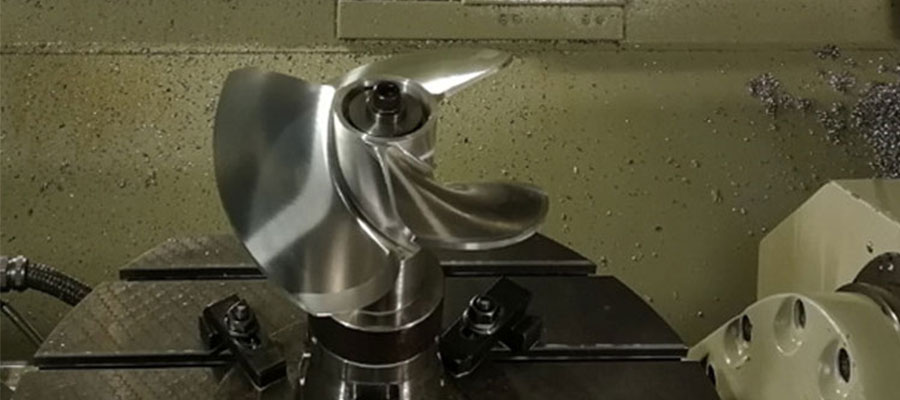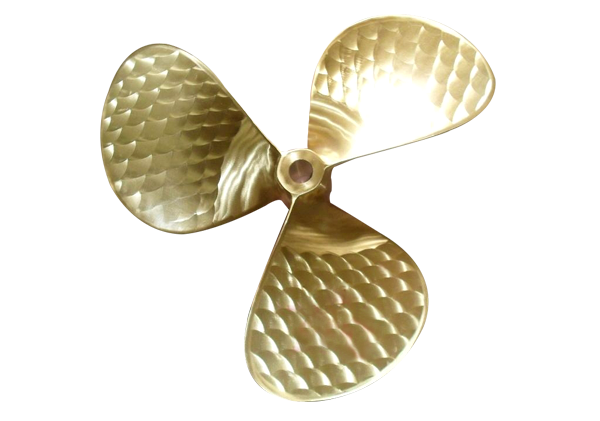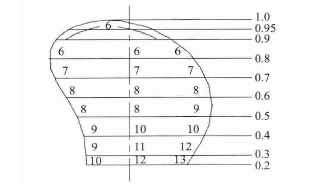Introduction To The Casting Process Of Large Copper Alloy Propellers
| In recent years, with the booming development of the world’s shipbuilding industry, the tonnage of shipbuilding has increased significantly, resulting in the increasing weight of marine propellers. Because the propeller is subjected to huge loads when operating in seawater, the mechanical properties and quality requirements of the casting are very strict, and the shape of the propeller blades are all complex curved surfaces, which makes the casting process of large propellers quite complicated. |

Modeling method
Due to the complex shape of the ship propeller blades and the large outline size of the super-large propeller, the overall molding technology is particularly critical. The quality of the molding is not enough, which may cause the casting to fail in size and seriously cause the casting to be scrapped. Therefore, the modeling process of the propeller is particularly important.
 At present, the shape of the propeller generally uses a digital display pitch gauge, a cross-section template, an angle line template and manual modeling. The sand data is lodged using a CAD computer. These data must consider the deformation of the casting, the shrinkage characteristics of the alloy, and the appropriate machining allowance . After the sand mold is manufactured, the inspection template such as the cross section template and the angle line template is used to review the leaf shape size to ensure that the data meets the requirements.
At present, the shape of the propeller generally uses a digital display pitch gauge, a cross-section template, an angle line template and manual modeling. The sand data is lodged using a CAD computer. These data must consider the deformation of the casting, the shrinkage characteristics of the alloy, and the appropriate machining allowance . After the sand mold is manufactured, the inspection template such as the cross section template and the angle line template is used to review the leaf shape size to ensure that the data meets the requirements.
Determination of shrinkage
The paddle blade is wide and the blade thickness is unevenly distributed. The maximum thickness of the blade heel is 336mm and the blade tip is only 22mm. The gap is so large that the casting temperature and cooling speed are different throughout the casting. However, the factors and laws that affect the deformation have not been fully understood. The leading edge is concave downward, and the edge is flexed upward, the blade is deformed torsion, and the pitch becomes smaller. Therefore, it is technically stipulated that the shrinkage rate of (0.2 ~ 0.4) R pitch is 1.0%, the shrinkage rate of (0.5 ~ 0.7) R is 2.0%, and the shrinkage rate of (0.8 ~ 1.0) R is 3.0%; the overall line The shrinkage rate is taken as 1.5%.
 |
||
| Figure 1 Machining allowance of blade back |
Determination of machining volume
In order to reduce the surface defects of the castings and obtain castings with qualified dimensions and good surface quality, the requirements of shrinkage and deformation alone cannot meet the requirements, and the machining allowance must be appropriately added. The machining allowance of the blade is determined as follows: leave the machining allowance on the blade surface; leave the machining allowance on the blade surface; see Figure 1 for the machining castings allowance of the blade back; 20mm; 10mm on one side of the outer circle of the hub, 15mm on one side of the inner hole of the hub, 15mm longer at the big end of the hub, and 10mm longer at the small end.
Gating identified
Since the material of the propeller ZCuAl9Fe4Ni4Mn2 contains more Al, it is easy to form secondary oxide slag during the pouring process. Therefore, in the design of the pouring system, it should be considered whether the pouring system can ensure the smooth filling of the metal liquid, and it should have reasonable pouring Speed, slag blocking and slag removal ability to prevent turbulence. Bottom injection is usually adopted, and the general cross-section ratio of the pouring system is straight: horizontal: internal = 1: (2 ~ 2.5): (10 ~ 30). Due to the large gross weight of the casting, two φ60mm straight runners and 26 φ60mm are used. Inside the gate.
The overall contraction of the copper alloy propeller is about 1.5%, so the design of the riser is also very important. Generally, the height of the riser is 0.6 to 0.8 times the height of the hub.
Baking and cooling
The mold is dried by a hot air blower, which mainly reduces the moisture in the molding sand and reduces defects such as porosity and oxidized slag due to the excessive moisture content in the molding sand. For uniform drying, the air outlet at the blade tip is opened at the lowest point along the side of the paddle. The mold is kept at 150 ° C for about 24 hours to ensure that the air outlet temperature is not lower than 40 ° C.
Because the paddle blade has a large thickness gradient, it will inevitably cause different cooling times of various parts. In order to ensure that the casting has sufficient strength, the heat preservation of this casting is not less than 120h after pouring. When the temperature drops to 300 ° C, boxing is performed. By extending the cooling time, the casting can fully release the casting stress to prevent blade deformation due to the large temperature gradient.
Link to this article: Introduction To The Casting Process Of Large Copper Alloy Propellers
Reprint Statement: If there are no special instructions, all articles on this site are original. Please indicate the source for reprinting:https://www.cncmachiningptj.com/,thanks!
 PTJ® provides a full range of Custom Precision cnc machining china services.ISO 9001:2015 &AS-9100 certified. 3, 4 and 5-axis rapid precision CNC machining services including milling, turning to customer specifications,Capable of metal & plastic machined parts with +/-0.005 mm tolerance.Secondary services include CNC and conventional grinding, drilling,die casting,sheet metal and stamping.Providing prototypes, full production runs, technical support and full inspection.Serves the automotive, aerospace, mold&fixture,led lighting,medical,bicycle, and consumer electronics industries. On-time delivery.Tell us a little about your project’s budget and expected delivery time. We will strategize with you to provide the most cost-effective services to help you reach your target,Welcome to Contact us ( [email protected] ) directly for your new project.
PTJ® provides a full range of Custom Precision cnc machining china services.ISO 9001:2015 &AS-9100 certified. 3, 4 and 5-axis rapid precision CNC machining services including milling, turning to customer specifications,Capable of metal & plastic machined parts with +/-0.005 mm tolerance.Secondary services include CNC and conventional grinding, drilling,die casting,sheet metal and stamping.Providing prototypes, full production runs, technical support and full inspection.Serves the automotive, aerospace, mold&fixture,led lighting,medical,bicycle, and consumer electronics industries. On-time delivery.Tell us a little about your project’s budget and expected delivery time. We will strategize with you to provide the most cost-effective services to help you reach your target,Welcome to Contact us ( [email protected] ) directly for your new project.
Link to this article:Introduction To The Casting Process Of Large Copper Alloy Propellers
Reprint Statement: If there are no special instructions, all articles on this site are original. Please indicate the source for reprinting.:ODM Wiki,thanks!^^